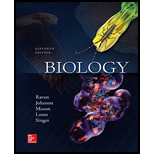
You have discovered a new organism living in tide pools at your favorite beach. Every so often, one of the creature’s appendages will break off and gradually grow into a whole new organism, identical to the first. This is an example of
a. sexual reproduction.
b. fission.
c. budding.
d. parthenogenesis.
Introduction:
The biological process of the formation of offspring from their parents is known as reproduction. It is a fundamental feature of life. Reproduction occurs in two forms, asexual reproduction and sexual reproduction.
Answer to Problem 1U
Correct answer:
The creature appendages break off and gradually grow into a whole new organism. This is an example of budding. Therefore, option c. is correct.
Explanation of Solution
Reason for the correct statement:
Budding is a type of asexual mode of reproduction. In this type of reproduction, the new organism develops from the bud or outgrowth occurs because of the division of cells.
Option c. is given as “budding”.
As “budding is the reason for the gradual growth of broken appendage into the whole organism”, it is the right answer.
Hence, option c. is correct.
Reason for the incorrect statements:
Option a. is given as “sexual reproduction”.
The organism is produced by the fusion of gametes, involving male’s sperm and female’s egg. Thus, it is a wrong answer.
Option b. is given as “fission”.
It is a type of sexual reproduction in which the cell divides into two parts and each part has the potential to grow into the organism of the same size as of the original. Thus, it is a wrong answer.
Option d. is given as “parthenogenesis”.
It is the type of asexual reproduction in which the development of the organism takes place from the unfertilized egg. Thus, it is a wrong answer.
Hence, options a., b. and d. are incorrect.
Conclusion:
Budding is the type of asexual reproduction that results in the gradual growth of a new organism from the broken appendages.
Want to see more full solutions like this?
Chapter 52 Solutions
Biology
- Which of the following characterizesparthenogenesis?(A) An individual may change its sex during itslifetime.(B) Specialized groups of cells grow into newindividuals.(C) An organism is first a male and then a female.(D) An egg develops without being fertilized.arrow_forwardYou are studying reproduction in starfish (also known as sea stars). You are able to successfully extract sperm and eggs from individuals in the lab and artificially fertilize the eggs. What is the first thing you expect to see in the zygote/embryo after successful fertilization? Group of answer choices a. development of organs b. development of a barrier against sperm entry c. rapid cell division WITHOUT growth d. rapid cell division with growtharrow_forwardWhat is a likely evolutionary advantage of sexual reproduction over asexual reproduction? a. sexual reproduction involves fewer steps b. less chance of using up the resources in a given environment c. sexual reproduction results in greater variation in the offspring d. sexual reproduction is more cost-effectivearrow_forward
- Genetically unique individuals are produced through ________. a. sexual reproduction b. parthenogenesis c. budding d. fragmentationarrow_forwardWhat is a likely evolutionary advantage of sexual reproduction over asexual reproduction? a. Sexual reproduction involves fewer steps. b. There is a lower chance of using up the resources in a given environment. c. Sexual reproduction results in variation in the offspring. d. Sexual reproduction is more cost-effective.arrow_forwardYou are studying reproduction in starfish (also known as sea stars). You are able to successfully extract sperm and eggs from individuals in the lab and artificially fertilize the eggs. What is the second thing you expect to see (from this list) in the zygote/embryo after successful fertilization? Group of answer choices A. development of a barrier against sperm entry B. rapid cell division without growth C. rapid growth and cell division D. development of organsarrow_forward
- What is Reproduction? Explain how humans reproduce their young ones?arrow_forwardWhich form of reproduction is useful to an animal with little mobility that reproduces sexually? a. fission b. budding c. parthenogenesis d. hermaphroditismarrow_forwardDouble fertilization means that(A) flowers must be pollinated twice to yield fruits and seeds.(B) every egg must receive two sperm to produce an embryo.(C) one sperm is needed to fertilize the egg, and a second spermis needed to fertilize the polar nuclei.(D) every sperm has two nucleiarrow_forward
- An organism produced a new individual without any help of another individual. A.Parthenogenesis B.Asexual Reproduction C.Sexual Reproduction D.Isogamy E.Sporulationarrow_forwardWhich type of life cycle has both a haploid and diploid multicellular stage? a. an asexual life cycle b. diploid-dominant c. haploid-dominant d. alternation of generationsarrow_forwardCompare and contrast sexual and asexual reproduction. Identify the most accurate statement. a. Asexual reproduction results in more offspring per mother. b. Sexual reproduction is always more costly. c. Sexual reproduction is associated with an increase in homozygosity. d. Asexual reproduction is always bad for a species.arrow_forward
 Concepts of BiologyBiologyISBN:9781938168116Author:Samantha Fowler, Rebecca Roush, James WisePublisher:OpenStax College
Concepts of BiologyBiologyISBN:9781938168116Author:Samantha Fowler, Rebecca Roush, James WisePublisher:OpenStax College
